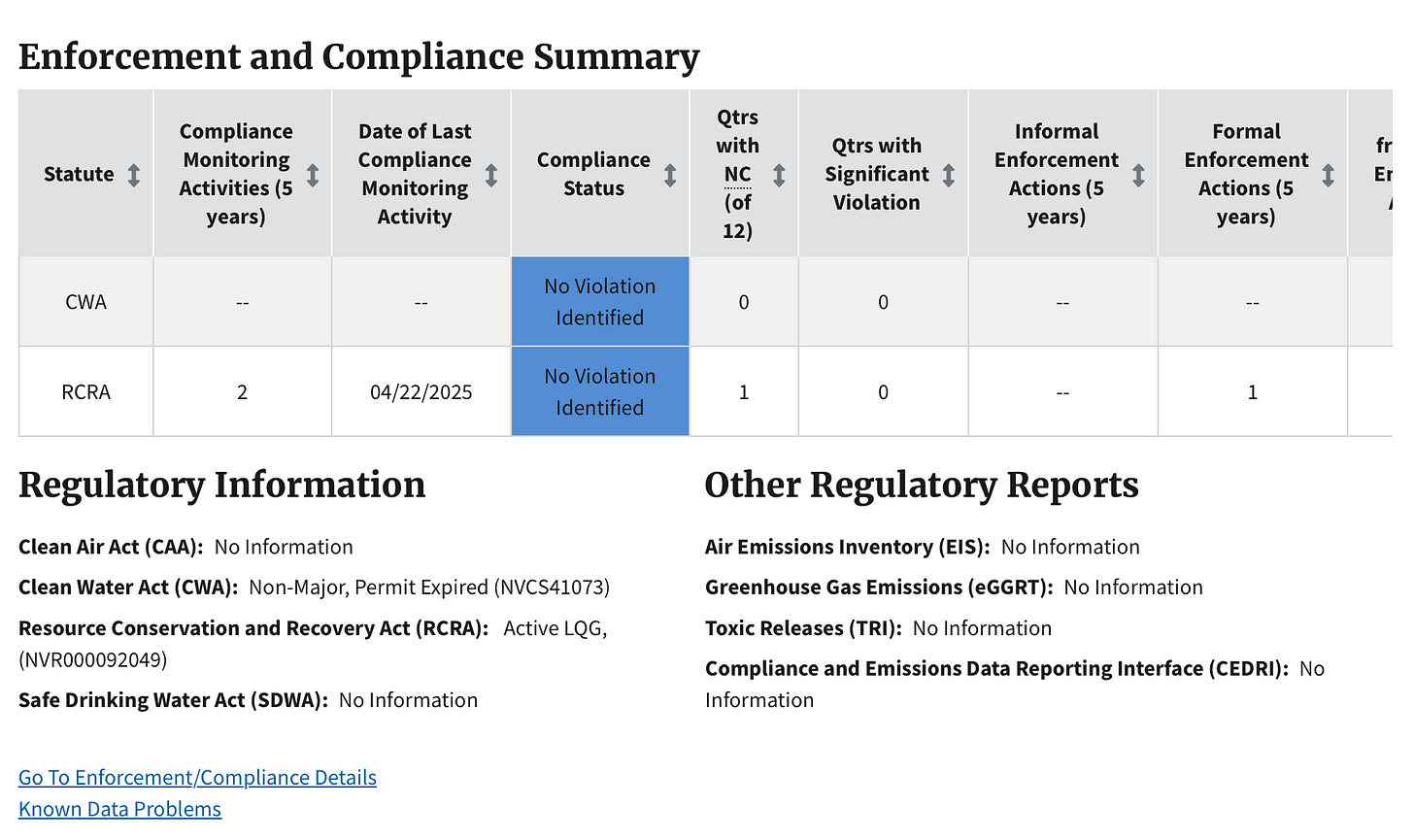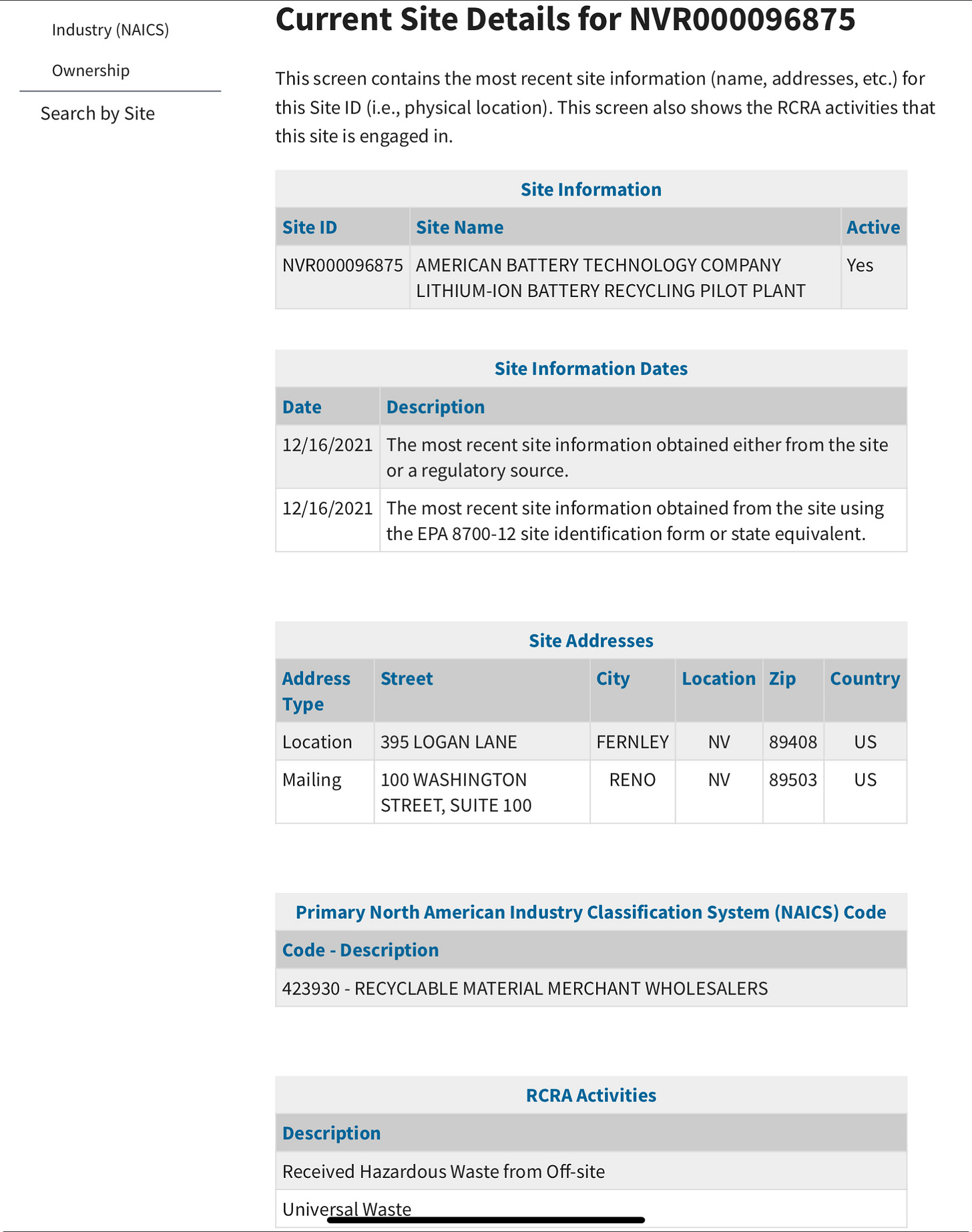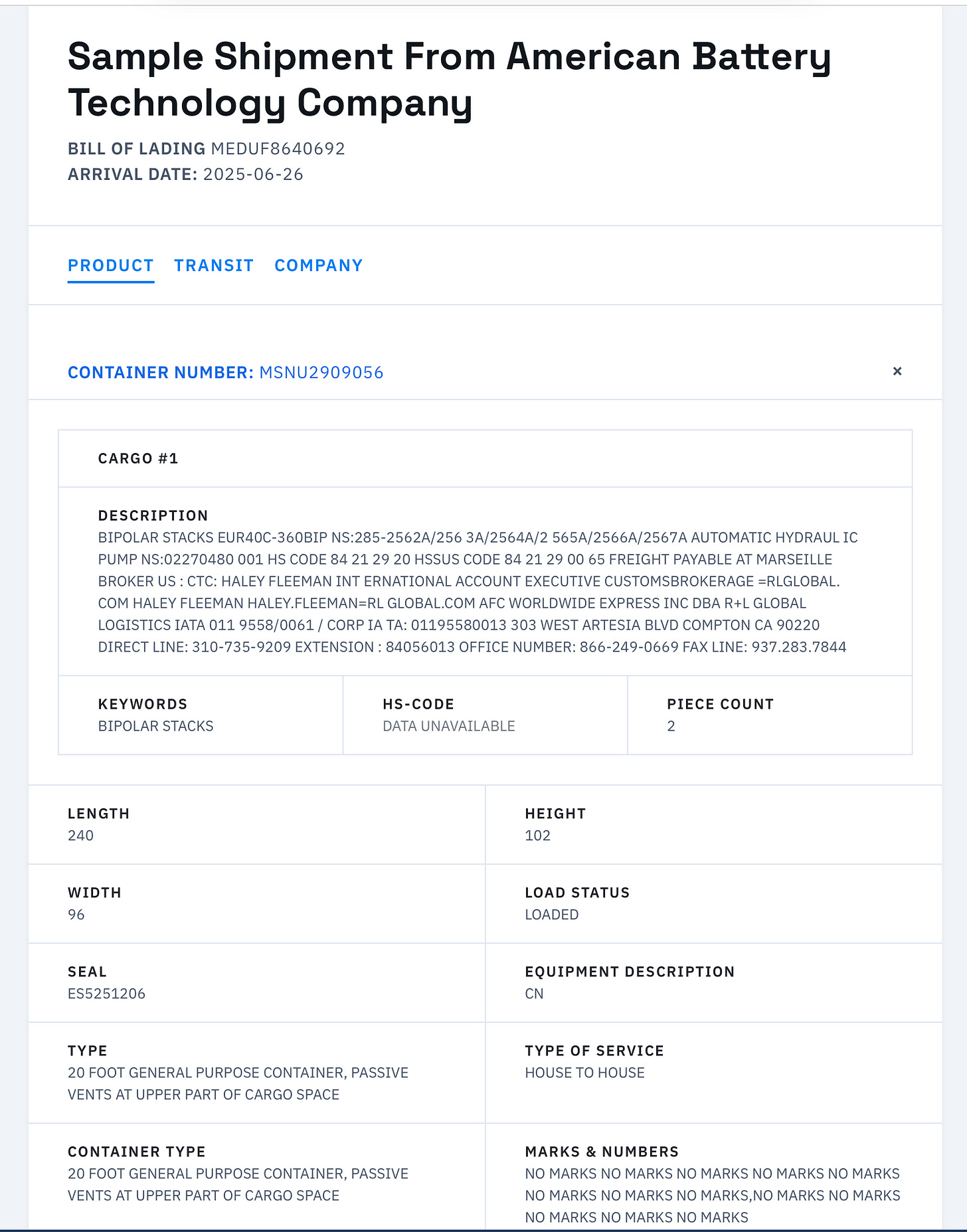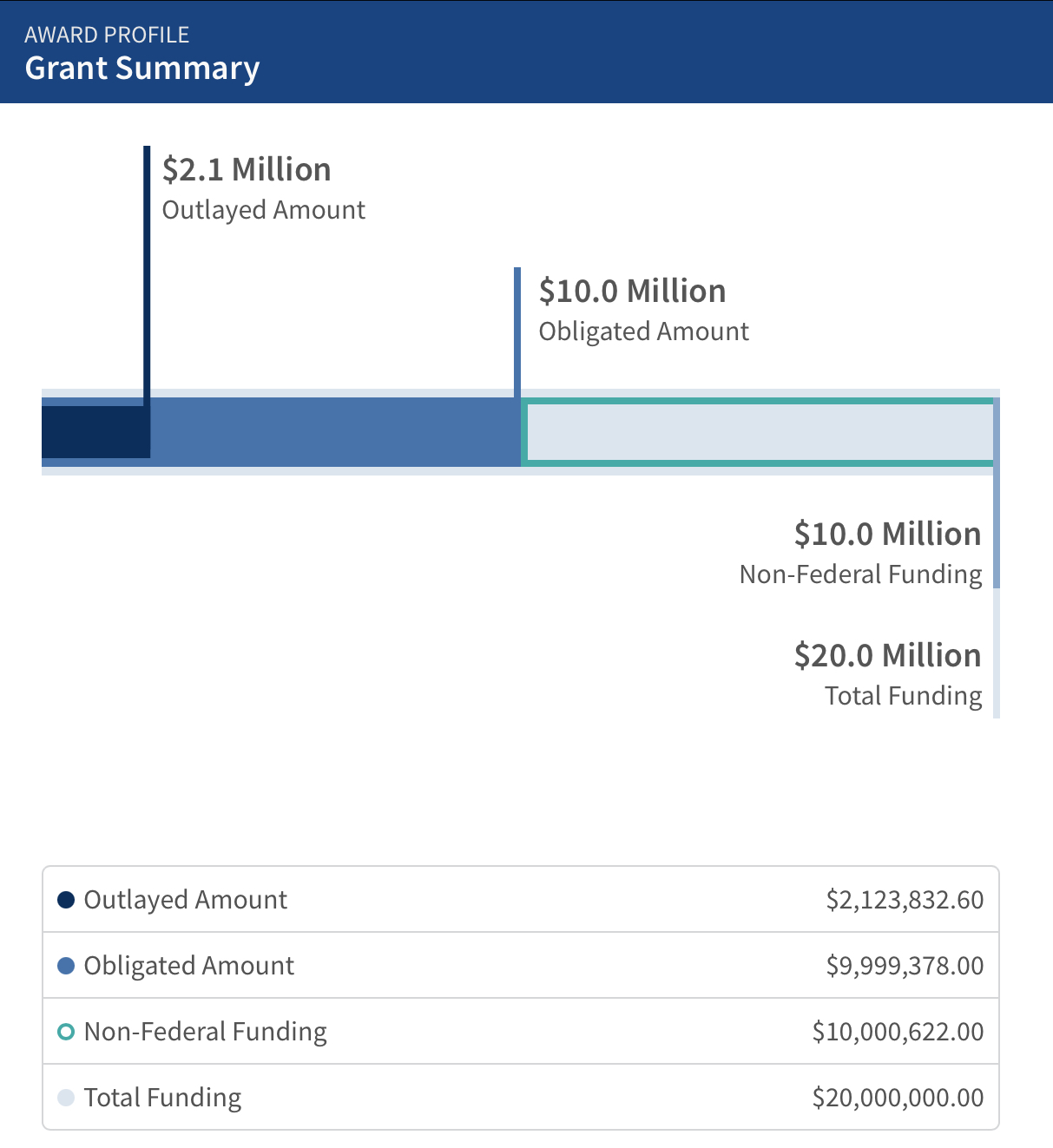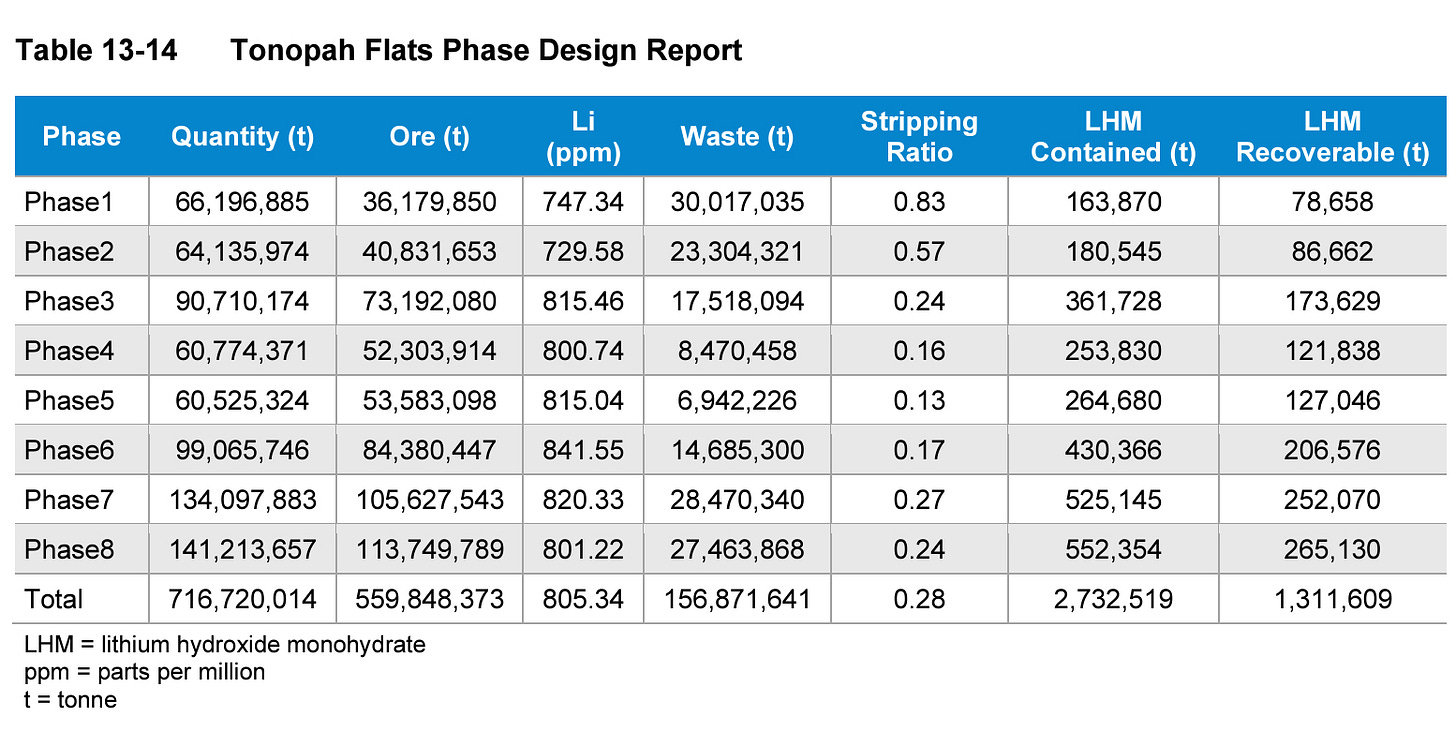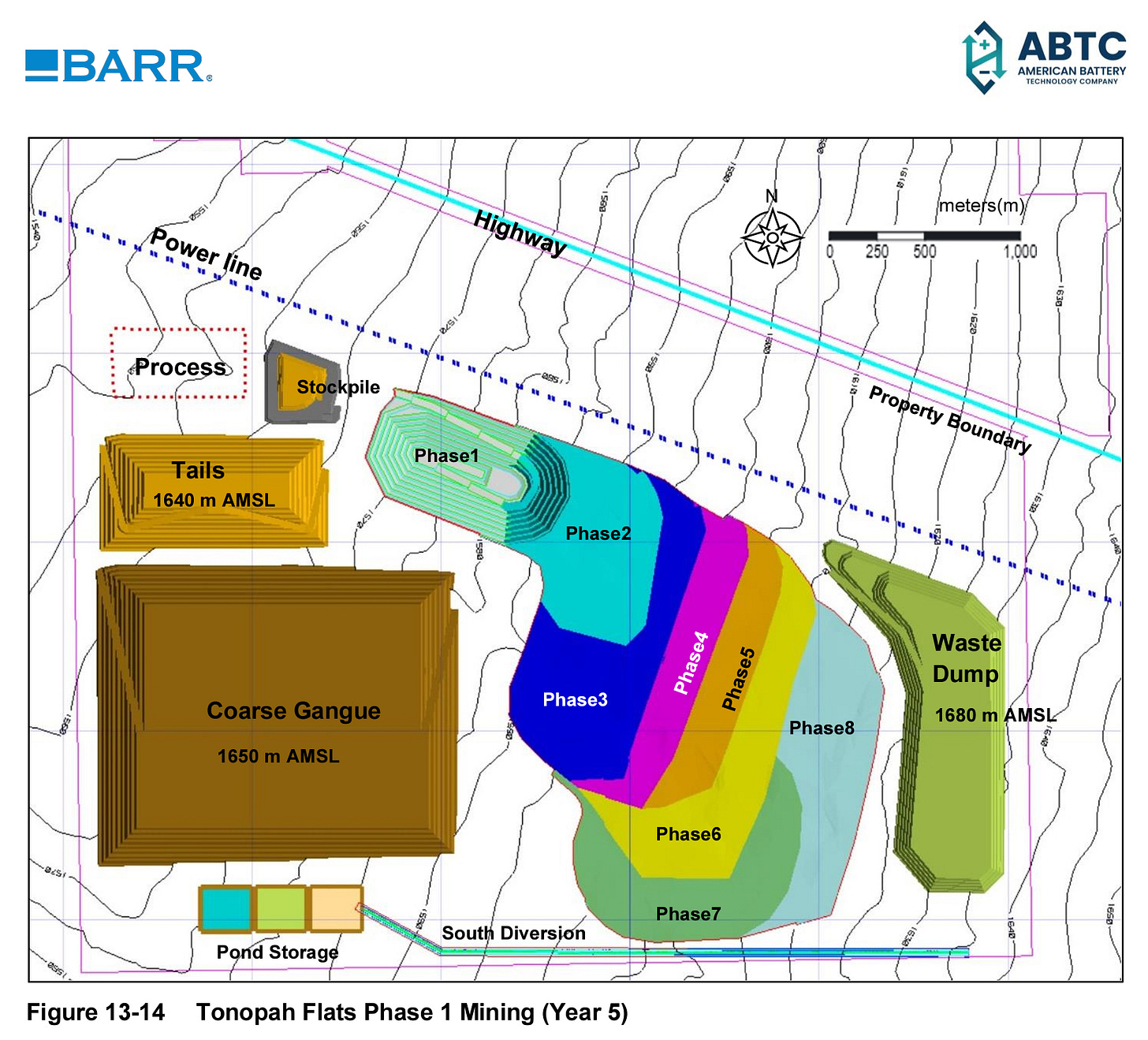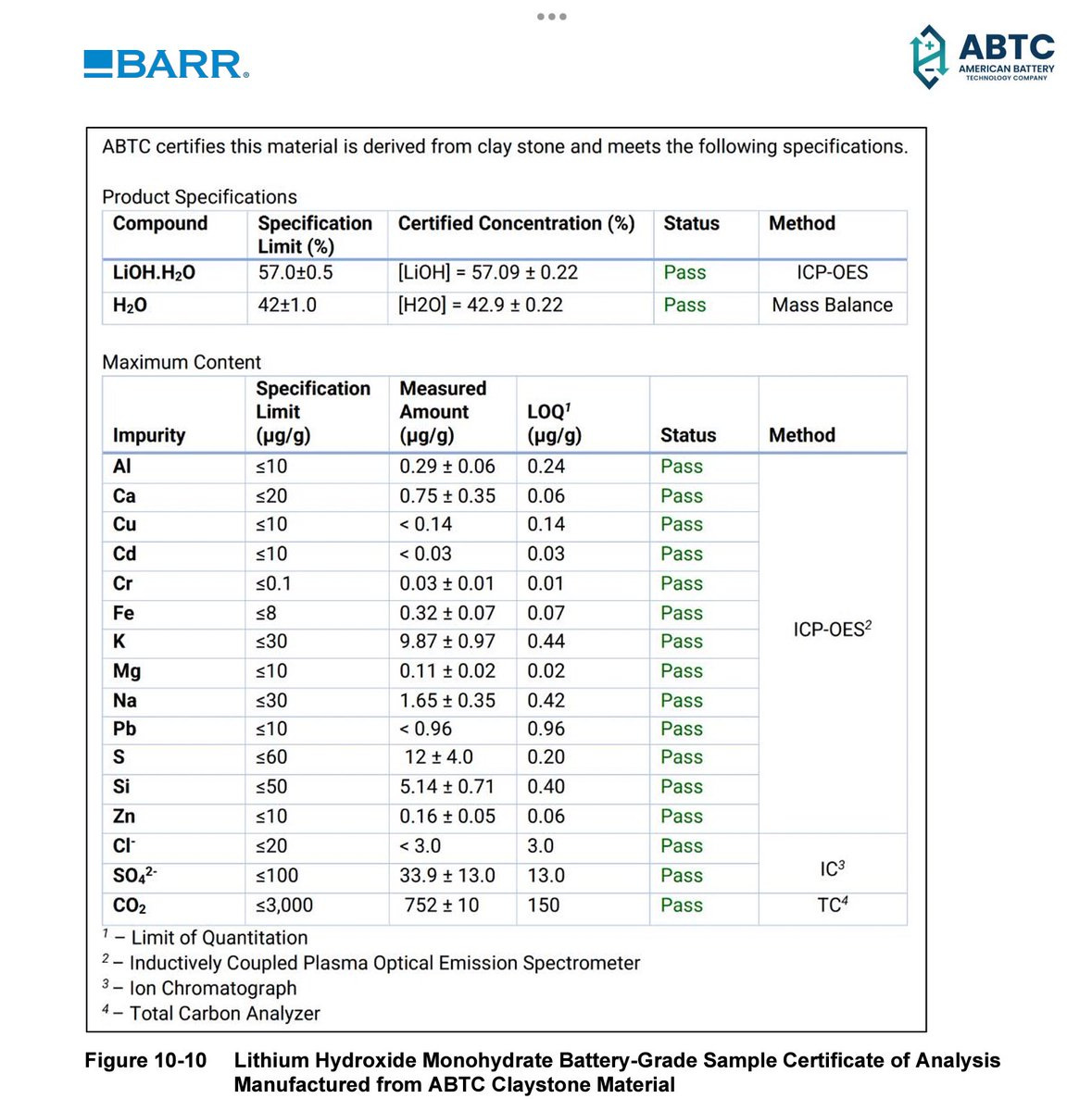American Battery Technology Company 2025 Shareholder’s Meeting Primer.
A lot has happened for the lithium-ion recycling company American Battery Technology Company (ABTC NASDAQ: ABAT) over the last quarter, both good and bad. But based upon my DMs and the confusion and misinformation I am seeing on social media much of it is not understood. The yearly shareholders meeting will be this Thursday and so felt that a primer for that meeting was needed.
The best way to judge a quarter, of course, is with the 10Q, the quarterly earnings. For a lithium-ion recycler, or any type of recycler, the best way to judge its performance is to look at their recycling efficiency, which is calculated by dividing the total amount of material sold into the market by the total amount of feedstock used and multiplying by 100. Since the company does not provide this to retail, and the most likely reason for this is that they are currently not selling much into the market, but rather charging a tolling fee and stockpiling in the intermediate, for example, black mass. Perhaps when Phase 2 is online we will get a better idea of the overall business model.
The next best metric is revenue compared to cost of goods sold (COGS), which can be reported in two ways. The first, known as cash COGS, measures only direct production costs such as materials and labor. The second includes these direct costs plus additional expenses such as overhead, storage, and processing. The company provides both, but the one we will use is cash COGS. We can then use the revenue to calculate a quasi-operating margin. Looking back, we can examine the last fiscal year’s cash COGS margin.
We can clearly see progress over the fiscal year 2025, and while the cash COGS increased so did the revenue. As the company fine tuned the efficiency the revenue went up till they were only at a -39% margin in Q4 Fy2025. Then something changed in the first quarter of FY 2026, and the reasoning for this is not clearly started but some have speculated that it was due to the company shutting down to make modifications to get a Comprehensive Environmental Response, Compensation, and Liability Act (CERCLA) format the EPA. However per the 10Q this is not true.
In May 2025, the Company received formal approval from the US EPA that its battery recycling facility in McCarran, Nevada had been approved for classification to receive waste material under the “Comprehensive Environmental Response, Compensation, and Liability Act” (CERCLA). This certification allowed ABTC to be one of the only battery recyclers in the Western US to be capable of receiving batteries that had been damaged and classified as CERCLA waste, such as battery materials that had been involved in large scale battery energy storage system (BESS) thermal events and fires.
In fact we know the exact day the EPA logged the review which was in April with the approval the following May.
Then they do state that they needed downtime to make operational upgrades, but that was in the following quarter after the EPA review, and there is no subsequent re-inspection listed on the EPA site. One can only assume, then, that this was not regulatory-mandated but necessary operational upgrades needed by the company for processing and not for EPA qualifications.
ABTC was awarded a contract and has already started receiving material for the recycling of up to 10,000 tonnes of damaged batteries from the Moss Landing BESS facility near Monterrey, CA. As one of the largest battery recycling projects in the history of the US, ABTC implemented several weeks of downtime within the quarter ended September 30, 20205 to implement facility upgrades to be able to successfully win this contract and process this immense amount of battery material.
But revenue dropped from $2.8 million to $0.94 million, a decrease of $1.86 million (66%), and while cash COGS decreased from $3.9 million to $3.3 million, a decrease of $0.6 million (15%), we need to look at the regular COGS, which includes overhead and would be directly increased by the upgrades. Regular COGS decreased from $5.1 million in Q4 FY2025 to $4.45 million in Q1 FY2026, a decrease of $0.65 million, or approximately 13%.
Based on these three-month figures, the magnitude of the revenue drop suggests the downtime had to last most of the quarter, likely around two-thirds of the quarter, and during that time the COGS dropped which would not make sense if they were actively upgrading the system. This leads me to believe the reason for the drop in revenue was due to the availability of feedstock, which can be seen in the inventory.
From June 30, 2025, to September 30, 2025:
Raw materials decreased from $216,052 to $28,336, a drop of $187,716 (87%).
Finished goods decreased from $192,095 to $75,794, a drop of $116,301 (61%).
Total inventories decreased from $408,147 to $104,130, a drop of $304,017 (74%).
Now, if the company is using a tolling model, where they are paid by an OEM to process material, a standard client and vendor arrangement in recycling, we would expect normal fluctuations in feedstock each quarter. However, the changes we see here are a statistical anomaly and cannot be explained by the typical fluctuations in feedstock for a tolling model.
There is also the question of the 10,000 tonnes of damaged batteries; this many have been the bases for the $30 million in revenue
At current market prices, if ABTC were to process all of the battery materials from the site, the value of recycled products generated from these materials is estimated at approximately $30 million.
After doing some restaurant math I think this incorrect or highly exaggerated and all we have to do is look at the filing that has the contract.
WHEREAS Veolia controls a minimum of 35,156 accessible modules accounting for 6,892,340 pounds or 3,126 MT of LG Lithium-Ion battery products, including intact non-DDR, intact DDR, as part of the Veolia Moss Landing Phase 1 Project (“Moss Landing”)
I did a X post covering this amount, and right now based upon the official contract in an official SEC filing from the company, they are nowhere near 10,000 tonnes unless they are withholding parts of the contract. At best with what is in the contract and based upon NMC Black Mass prices from Shanghai Metal Market (SMM) they are looking at around $12 Million. If you need more context the facility is rated at 20,000tpa of feedstock, the amount listed in that contract is not a significant portion of the design capacity.
Next, we need to look at the dilution. Last quarter, they filed an S3 for a $250 million shelf, which was later withdrawn in an RW form. The reasoning for this was so they could file an S3ASR, which is an automatic shelf registration that allows the company to quickly issue shares from the shelf without additional SEC review. They filed the S3ASR the next day for $100 Million which is way less than the shelf, and as such less dilution. But how is the share structure looking?
Through the issuance of common stock under the ATM, the Company received aggregate gross proceeds of approximately $23.6 million (before deducting commissions and other offering expenses). As a result, the number of outstanding shares increased from 118,046,888 on September 15, 2025, to 129,969,958 on November 3, 2025, an increase of 11,923,070 shares, or approximately 10.1%. Following this, the Company’s net cash position improved to $54.9 million as of November 3, 2025.
ABTC is using equity to compensate employees and executives, resulting in dilution for shareholders. In the three months ended September 30, 2025, the company granted 5.28 million warrants, issued 4 million shares from exercised warrants, and awarded 8.1 million share awards under its Retention Plan.
As of September 30, 2025, there were 18.5 million warrants and 14.1 million unvested share awards outstanding, with $18.1 million in unamortized expense to be recognized over the next 3.5 years.
They also were able to, and if you have been reading my posts about the company you would know I listed this as one of their top priorities, to eliminate all of the secured notes from High Trails. The original Purchase Agreement, dated August 29, 2023, allowed the Company to sell up to $51 million of senior secured convertible notes, of which $25 million was initially received. The notes included complex conversion features, frequent amendments, and derivative accounting considerations, which increased the effective cost to the Company and created significant dilution risk.
Over time, the Company made partial payments in cash and shares, notable share conversions included:
July 18, 2025: 6,666,651 shares
August 20, 2025: 2,835,299 shares
These conversions alone would have netted High Trails around $22 million if the shares were sold shortly after conversion. In total, the Company originally received $37 million from High Trails in two tranches:
August 2023: $25 million
November 2024: $12 million (approximately $9 million net after fees)
Of this, $31.5 million has been repaid in cash toward the Notes principal, with an additional $8 million repaid via shares. After accounting for debt discounts, $7.73 million of principal remained outstanding prior to the final conversions. The 2024 Notes were amended several times, including adjustments to conversion rates, and partial principal payments were made via common shares, all recorded according to accounting standards.
As of September 30, 2025, the carrying value of the notes payable of $8,000,000 was fully extinguished. The notes were fully extinguished primarily through conversion into common stock and no amounts remain outstanding. The structure and frequent amendments of the High Trails notes clearly illustrate the toxic nature of this debt, which caused significant dilution and financial strain on both the company and the shareholders and for me is the main positive highlight in the Q1 Fy2026 filing.
In the last earnings it was announced that they had removed the Fernley property from the market and instead will invest capital into and seek a certificate of occupancy. This includes the unfinished building, the land it is on and the parcel across the street that was bought for a dual purpose to grant emergency access to responders and to be a universal waste storage faculty.
An impairment loss of $10.2 million on assets held-for-sale was recorded in the fiscal year ended June 30, 2024, related to two parcels of land and a building at the Fernley, Nevada location, comprising 12.44 acres and 11.55 acres, that the Company decided to sell. As of June 30, 2024, these assets had a carrying value of $8.4 million. As of June 30, 2025, the 11.55 acres of land was no longer actively marketed for sale and was therefore reclassified back to property, plant, and equipment. As of June 30, 2025, the remaining land and building has a carrying value of $6.0 million, is included within assets held for sale on the consolidated balance sheet, and is subject to further impairment, if required, until the asset is sold.
The $6.0 million amount can be now seen in the Property Plant and Equipment (PP&E) table.
We can compare this to the previous quarter and make an educated guess that the Fernley site is the amount listed in Construction in progress. What the actual use of that facility will be has not been answered. However based upon a few items such as they are currently running a just in time model for feedstock, this means they can only accept a amount of feedstock that they can properly process in a set period like 24 hours.
This could mean they plan to use it for short term storage. Now while the EPA seems rather lax on updating their database we can see the site has been approved in the past at least for universal waste and to receive hazardous waste, so it may not take much to convert it into a strictly short term sorting and storage facility. I documented much of the sites construction on my YouTube channel.
This comparison also brings up a question about this statement we looked at earlier:
ABTC implemented several weeks of downtime within the quarter ended September 30, 20205 to implement facility upgrades to be able to successfully win this contract and process this immense amount of battery material.
Between June 30 and September 30, 2025, the company’s building value increased from $16,653,019 to $16,657,984, a rise of $4,965, or approximately 0.03%, while equipment and vehicle values increased from $52,241,975 to $58,607,711, an increase of $6,365,736, or about 12%. So we do see they did invest in equipment and what could be the amount spent on the upgrades.
Final note on the PP&E table At one point due to some long time investors it was discovered the company was doing a second attempt at a sale leaseback where they would sell the TRIC facility then lease it back with an option to buy. It is unknown the exact status of that but the listing has been pulled or maybe hidden after people started to post about it on social media. But it included $10 million for equipment for the facility.
The status of Phase 2 is asked almost every day, but for the past two years, there has been no real answer. Phase 2 is where intermediates like black mass are converted into usable battery-grade materials, also called the value end product. Clues such as a shipping manifest for a bipolar stacks point to Phase 2, since the shipment occurred in June, long after the claystone demonstration plant, which uses the same technology, came online.
Now there are quite a few posts, mostly from the usual suspects on social media platforms like StockTwits that keep posting the Phase 2 is active or some such gobbledygook. They are misinterpreting filings from the Nevada Department of Environmental Protection (NDEP) which is for Phase 1 System 2, the slurry dewatering stage, where the moisture from the black mass is extracted, filtered and any trace materials that can be recovered are.
At this time there is no official or unofficial evidence that Phase 2 has progressed beyond concept.
Now onto Tonopah…
ABTC received a $115.5 million ($57 million cost share)Department of Energy (DOE) grant in September 2023 to build a large scale (5,000tps) demonstration plant to produce battery cathode grade lithium hydroxide, with costs shared equally between the DOE and the Company.
In May 2025, the grant underwent an audit, and on October 9, 2025, the DOE terminated the grant effective August 31, 2025. The Company has appealed the termination and plans to pursue dispute resolution while continuing the project on schedule, having already raised over $52 million from public markets.
Now then a lot of questions have been raised, I know I asked a few with no answers, which I will address later in this article. But it just doesn’t seem logical for the DOE to pull what is clearly a vital project for the national security and economic growth of the United States. That was until a statement from a DOE representative was released.
These projects had missed milestones, and it was determined they did not adequately advance the nation’s energy needs, were not economically viable, and would not provide a positive return on investment of taxpayer dollars.
Because the grant was federal, the company was required to get NEPA approval, and the only activity that was ever listed on an official government website was the Categorical Exclusion for Budget Period 1, which is the stage where the design and plans for the facility would be hammered out.
There was to be 5 Budget Periods over the 5-year lifespan of the grant. From the time the grant was announced to the cancellation, it seems they had only progressed to Budget Period 1. So the missed milestone is more than likely the reason for the cancellation, and with the history of the company missing deadlines, this is not a surprise. The rest of the reasoning is clearly bullarkey, since the Tonopah project was also added as a covered project on the FAST-41 dashboard due to its national security and economic importance.
This leaves the company with 2 federal grants active, the South Carolina Grant (DEMS0000104) that is also shared with the Argonne National Lab for roughly $123 million with a total project amount of $347 million. As of the writing of this article November 10th, they have been reimbursed $822,993.90 and per the an official US goverment website USASpending.gov the grant is still active.
You can read more about it in my article FOIA Documents for American Battery Technology Company’s South Carolina Grant.
Next would be the research and development grant (DEEE0010396) for there novel lithium-ion recycling technologies that will be incorporated into the companies platform.
Active Anode Recovery and Regeneration
Liquid organic electrolyte separation
Non-thermal crystallization of cathode metal products
This one is for $10 million with a total project amount of $20 million, and they have been reimbursed for $2,123,832.60 and per the an official US goverment website USASpending.gov the grant is still active.
You can read more about it in my article ABTC’s DOE 2025 Annual Merit Review Presentation for their $10 Million Grant
They also have two 45C tax credits: one for $40 million, which can be used for the South Carolina facility, and one for $20 million, which can be used for the TRIC facility. As far as we know, both are still active, with the company stating they can utilize or monetize the TRIC tax credit now.
The final federal funding the company has is a $1 million DOE collaborative agreement with Argonne National Laboratory, using the Advanced Photon Source and Aurora Exascale Supercomputer. ABTC’s lithium processing technology produces battery-grade lithium hydroxide with lower chemical use, reduced costs, and less environmental impact. Since this is not a grant there is no data on it, but we can assume it is still active.
The second-to-last thing I want to cover is the costs that were released in the Preliminary Feasibility Study (PFS) for the Tonopah Flats Lithium Project. I may go into more details in a later article where I do a more comprehensive comparison of the ABTC system to others, but for now I just want to do a quick cost comparison an look at the basics amounts and timetables.
While the overall cost is $6,994 per tonne of LHM over the life of the mine, since the main part of the investment thesis is that the company created a lower cost extraction and processing platform for claystone how does that compare to the Thacker Pass?
Tonopah Flats Lithium Project: $6,994 per tonne of LHM.
Thacker Pass: $7, 198, per tonne of LCE.
Of course there is a problem with them producing different precursors, but the price difference if Thacker Pass went with a dedicated LHM platform instead of doing a conversion from LCE to LHM the price difference would only be a few percentage points.
Difference in dollars: $7,198 − $6,994 = $204
Difference in percentage: $204 ÷ $7,198 × 100 ≈ 2.8 %
I think the reason we are not seeing such a drastic difference is that in the PFS for Tonopah it clearly shows more has to be done pre-extraction to concentrate the ore, while for Thacker Pass, with their brute-force extraction followed by impurity removal and waste processing, they do not need that pre-treatment. But this is why it is called a preliminary study, and this amount can change before a definitive or bankable study is released.
One of the main changes from the PEA to the PFS was that ABTC was able to redesignate part of the measured and indicated resources as a 2P reserve (proven and probable). What this does is allow the company to capitalize expenditures on the project instead of listing them as operating expenses, similar to someone remodeling a house, where the expenditures add value to the house. The amount in the reserves is expected to increase as more exploration is conducted, and it will also be adjusted up or down as the price of lithium fluctuates, because changes in price affect what is economically viable to mine.
Now while we have seen some documentation about the phases of the mine, the PFS lays them out over the life of the mine.
Pre-mining site development and earthworks: approximately six months
Pre-production mining (non-processing phase): approximately one year
Initial ramp-up production phase (5,000 tpa of LHM): 1-2 years
Full ramp-up phase achieving and sustaining 30,000 tpa: 1-3 years
Loading and transporting dry-stack tailings to the backfill dumps: year-6 to LOM
Over the life of the mine there will be a total of 8 phases. This table from the PFS shows the tonnes of rock and ore that need to be moved, the amount of waste, such as tailings, and the tonnes of recoverable lithium hydroxide monohydrate.
This below is a basic map, but it shows the layout of the mine, notice how close it is to the highway, transport as in roads is not going to be a major CAPEX for this project.
But really when it comes to Tonopah, and this is something I have posted about before, at the end of the day all that matters is that it can produce a lihtium precursor that meets OEM specifications. Lithium is source agnostic doesn’t matter where it comes from all that matters is that they prodcue what the client wants, and at a price that is viable. And based upon the PFS, once you get past all the fiddleybits, that is what it shows.
The FAST-41 dashboard shows that all of the necessary studies and plans have been submitted, and in fact, the day that I am writing this there is a milestone listed for today: “All Baseline Reports Accepted or Comments Provided (Agency Action).” After that, it’s just a waiting game for the BLM to issue a Notice of Intent (NOI) that kicks off the NEPA review.
And the last part I want to cover in this shareholder’s meeting primer is some questions. When we learned about the cancellation of DOE grants, I reached out to several companies that had their grants pulled. Some didn’t respond, and a couple of them I am now working with to provide answers to the public. ABTC declined to participate and gave this reason.
Due to the proprietary nature of our technologies and to ensure compliance with SEC regulations, I’m unable to provide information nor speculate beyond what is publicly available at this time.
This response was confusing since only one of the questions was even remotely related to the technology, and that was indirectly. The questions focused instead on policy and the company’s business model. I am reposting them here in case someone else at the company happens to notice and actually reads them.
Question #1
It was shown that Republicans are putting pressure on The Secretary of War Pete Hegseth to increase the production of domestic lithium. With President Trump’s Executive Order Immediate Measures to Increase American Mineral Production this was included:
The Secretary of Defense may use the authority under section 303 of the DPA, in consultation with the Secretary of the Interior, the Secretary of Energy, the Chair of the NEDC, and the heads of other agencies as the Secretary of Defense deems appropriate, for the domestic production and facilitation of strategic resources the Secretary of Defense deems necessary or appropriate to advance domestic mineral production in the United States.
Tonopah Flats clearly fits into the goal of the US creating a secured domestic supply of critical minerals, do you believe that ABTC and other companies will see more assistance going forward form the Department of War than the Department of energy?
Question #2
The grant was originally intended to support a demonstration-scale facility producing 5,000 tpa of lithium hydroxide monohydrate, now designated as Phase 1 in the PFS, with Phases 2 and 3 planned to add 12,500 tpa each for a total of 30,000 tpa. Was this staged expansion part of the original grant scope, or added later to reflect the project’s progression toward commercial scale, and given that 5,000 tpa is considered commercial for secondary sources but below typical commercial scale for primary sources, how does this impact the project’s pathway and potential scale-up?
Question #3
Tonopah Flats was initially listed as a transparency project and later upgraded to a covered project on the FAST-41 dashboard. While FAST-41 is intended to expedite projects, the specific benefits for each project type are not widely known. In the PFS, the required permits and studies for Tonopah Flats are outlined could you provide investors with more detail on how FAST-41 will help the company advance this project?
Question #4
In a statement, you mentioned the company is open to partnering with a larger mining company. Recently, Vulcan Energy announced an offtake agreement with Glencore for lithium. Would a partnership like this be what you described, or are you considering a joint venture where a mining company takes an equity stake in the project?
Question #5
While the lithium hydroxide monohydrate component of the extraction platform shares the same engineering elements as the one that will be used for your recycling platform, investors have long wondered if the SLE component could be deployed at other locations. If so, would the company explore offering it as a modular processing solution, providing the equipment and process expertise as a scalable service for third-party sites?
Question #6
One of the largest contributors to a mine’s OPEX is the collection, treatment, and storage of waste. How has ABTC’s development of a more environmentally sound process reduced this major cost contributor?
Question $6
The letter of intent from the Export-Import Bank of the United States seemed an unusual partnership for a company focused on creating a domestic lithium supply. Does this reflect the government’s goals of not only establishing a sustainable domestic lithium-ion production and manufacturing infrastructure but also expanding its reach globally?
The 2025 Shareholder’s Meeting will be held November 13th 2025 beginning at 12pm PST and shareholders will be voting on two items.
To elect five directors to the Company’s Board of Directors (the “Board”) to serve until their respective successors are duly elected and qualified; and
To ratify the appointment of KPMG LLP as our independent registered public accounting firm for our fiscal year ending June 30, 2026.
https://central.virtualshareholdermeeting.com/vsm/web?pvskey=ABTC2025
I will be hanging out in my Substack Chat during the meeting and will live commentary anything that catches my attention.
DISCLAIMER: This article should not be construed as an offering of investment advice, nor should any statements (by the author or by other persons and/or entities that the author has included) in this article be taken as investment advice or recommendations of any investment strategy. The information in this article is for educational purposes only. The author did not receive compensation from any of the companies mentioned to be included in the article.


